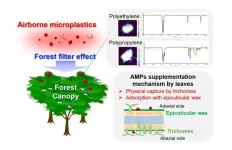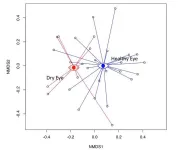(Press-News.org)
A research group led by Japan Women’s University finds that airborne microplastics adsorb to the epicuticular wax on the surface of forest canopy leaves, and that forests may act as terrestrial sinks for airborne microplastics
Tokyo, Japan – Think of microplastics, and you might think of the ones accumulating in the world’s oceans. However, they are also filling the sky and the air we breathe. Now, it has been discovered that forests might be acting as a sink for these airborne microplastics, offering humanity yet another crucial service.
In a recently published study, a multi-institutional research group led by Professor Miyazaki Akane of Japan Women’s University has used a new technique to measure the levels of microplastics adhering to the leaves of trees, revealing that forests are potentially acting as terrestrial sinks for these particles.
Microplastics have come into public focus within the last decade because of their effects on the environment and human health. Airborne microplastics are tiny plastic particulates(less than 100 µm) that become suspended in the atmosphere and dispersed throughout the environment, but it has been unclear where they end up. Forests have been known to accumulate airborne pollutants, but their ability to capture airborne microplastics has been poorly understood.
“We investigated airborne microplastics on konara oak tree leaves in a small forest in Tokyo,” says lead author of the study, Natsu Sunaga. “We wanted to determine a reliable method for analyzing levels of these microplastics on leaf surfaces, and how exactly airborne microplastics become trapped by leaves.”
The team examined the leaves of Quercus serrata, a species of oak representative of Japanese forests. To extract the plastics, the leaves were treated using three processes: washing with ultrapure water, simultaneous treatment with ultrasonic waves and washing with ultrapure water, and treatment with an alkaline solution of 10% potassium hydroxide.
“We found that airborne microplastics strongly adsorb to the epicuticular wax on the leaf surface,” explains Akane Miyazaki, senior author. “In other words, these particles accumulate when they stick to the waxy surface coating of leaves.”
The team discovered that the first two treatments – rinsing with ultrapure water alone or in combination with ultrasonic waves – were insufficient for accurately determining the levels of airborne microplastics on forest canopy leaves. Treatment with alkaline potassium hydroxide, however, removed both the epicuticular wax and the substances adhered to it, proving to be an effective method for detecting airborne microplastics stuck to leaf surfaces. Crucially, previous studies that used only the first two methods may have underestimated the number of plastics adhering to leaf surfaces.
“Based on our findings, we estimate that the Quercus serrata forests of Japan (~32,500 km2) trap approximately 420 trillion airborne microplastics per year in their canopies,” states Sunaga. “This indicates that forests may act as terrestrial sinks for airborne microplastics.”
How the accumulation of these microplastics will affect forest ecosystems, including ecosystem functions and soil health, is unknown, and this will undoubtedly be an area of further research. For now, we know that forests and even roadside canopies might reduce the amount of plastic entering our lungs, and for that we have yet another reason to thank trees.
###
Reference
Title of original paper : “Alkaline extraction yields a higher number of microplastics in forest canopy leaves: implication for microplastic storage”
DOI : 10.1007/s10311-024-01725-3
Journal : Environmental Chemistry Letters
Article Publication Date : 20 March 2024
Authors : Natsu Sunaga a, Hiroshi Okochi b, Yasuhiro Niida c, Akane Miyazaki a,*
a Graduate School of Chemical and Biological Sciences, Japan Women's University
b Graduate School of Creative Science and Engineering, Waseda University
c PerkinElmer Japan G.K.
*Corresponding author. Akane Miyazaki
About Japan Women's University
Japan Women's University was founded as Japan's first organized institution of higher education for women, and celebrates its 120th anniversary in 2021. It is the only private women's university with a Faculty of science, and is a women's comprehensive university with an educational environment that integrates the humanities and sciences. The Faculty of Transcultural Studies opened last year, and new faculties are scheduled to open in 2024 (Faculty of Architecture and Design) and 2025 (Faculty of Food Science (tentative name, under planning)). Under the tagline of "I move, and the world opens up," we are fostering human resources who can learn and act on their own initiative and create new value. For more information, please visit https://www.jwu.ac.jp.
END
The world-leading Dunedin Study is set to launch its age 52 assessments, delving into an understudied but important period of life and time of change.
The Dunedin Multidisciplinary Health and Development Study is a longitudinal study that follows the lives of 1037 babies born in Queen Mary Maternity Hospital between 1 April 1972 and 31 March 1973. It is the most detailed study of human health and development in the world.
Members have been assessed regularly throughout their lives, most recently at age 45.
Study Director, Research Professor Moana Theodore is incredibly excited ...
An opportunistic emergency department stop smoking prompt, comprising brief advice by a trained professional, an e-cigarette starter kit, and referral to local stop smoking services can help smokers quit, with a significant proportion of them still not smoking 6 months later, finds research published online in Emergency Medicine Journal.
Some 6.4 million people in the UK still haven’t stubbed out for good, and of the large numbers of people attending emergency departments, a substantial proportion are more likely to be smokers and have poorer overall health, explain ...
Consistently exercising 2-3 times a week over the long term is linked to a lower current risk of insomnia as well as the ability to clock up the recommended 6-9 hours of shut eye every night, suggests an international 10-year study published in the open access journal BMJ Open.
Regular exercise is associated with better overall health, and several studies have suggested that physical activity promotes better quality sleep and may improve symptoms of chronic insomnia, note the researchers.
But it’s not entirely clear how much gender, age, weight (BMI), overall fitness, general health and exercise ...
Peer reviewed – randomised controlled trial - humans
Giving out free e-cigarette starter packs in hospital emergency departments to people who smoke helps more people quit – according to research from the University of East Anglia.
The trial, funded by the National Institute for Health and Care Research (NIHR), offered advice, an e-cigarette starter pack and referral to stop smoking services to people attending A&E for any reason, to help them to stop smoking.
Six months later, almost one in four people given the starter packs said they had quit smoking. And those who received ...
Implementing a single shared digital prescribing record across the NHS in England could avoid nearly 1 million drug errors every year, stopping up to 16,000 fewer patients from being harmed, and saving up to 22 lives every year, suggests a modelling study, published online in BMJ Quality & Safety.
The figures, which are based on the assumption that such a system could reduce medication errors by at least 10%, and by as much as 50%, could also save £millions for the NHS, say the researchers.
Previously published research suggests that drug errors cost the NHS £98 ...
Using novel machine learning tools developed at Stanford Medicine, researchers have mapped three distinct cellular configurations that correspond to clinical outcomes for patients with a rare, difficult-to-treat cancer called soft tissue sarcoma.
In particular, the technique identified a cellular neighborhood that correlated with a positive response to immunotherapy, which may help physicians make treatment decisions.
“These cancers are challenging,” said Everett Moding, MD, PhD, an assistant professor of radiation oncology. “Up to half of patients diagnosed with a primary tumor will develop distant metastases, but we don’t have a good way to predict ...
A team of researchers from Columbia University Irving Medical Center (CUIMC) and Columbia Engineering has been awarded up to a $38.95 million contract from the Advanced Research Projects Agency for Health (ARPA-H) to build a living knee replacement from biomaterials and human stem cells, including a patient’s own cells. ARPA-H is a federal funding agency that funds transformative biomedical and health research breakthroughs, rapidly translating research from the lab to applications in the marketplace.
The Award
The award, part of the ARPA-H’s Novel Innovations for Tissue Regeneration ...
Take a puff of nicotine for the first time, and your DNA plays an important role, alongside social and environmental factors, in shaping what happens next.
In recent years, scientists have identified thousands of genetic variants believed to influence everything from when people first try smoking to how good that first cigarette feels to how often they light up and how hard it is to quit. Some variants influence how quickly we metabolize nicotine, while others underlie how sensitive we are to it. But little is known about how they interact with each other and with other genetic differences.
A new University of Colorado Boulder study sheds unprecedented ...
NORMAN, OKLA. – Binbin Weng, Ph.D., an engineering professor at the University of Oklahoma, has been awarded a National Science Foundation CAREER Award presented to early-career faculty with the potential to serve as academic role models in research and education. The $497,370 grant will fund his project “Enabling New States of Light in Mid-Wave Infrared Photonics for Gas Sensing Applications.”
Weng says there is a growing demand for distributed gas sensing networks capable of continuously monitoring gas threats on a broad scale. However, current technologies face significant challenges in size, power consumption ...
Researchers have used advanced sequencing technology to determine how the mix of microbes present in patients with healthy eyes differs from the mix found in patients with dry eye. The new work could lead to improved treatments for various eye problems and for diseases affecting other parts of the body.
Microbial communities in and on our body — collectively referred to as the human microbiota — play an essential role in keeping us healthy. Although many studies have focused on microbial communities in our gut, understanding the microbiota present in other body sites is critical for advancing our knowledge of human health and developing targeted interventions ...






